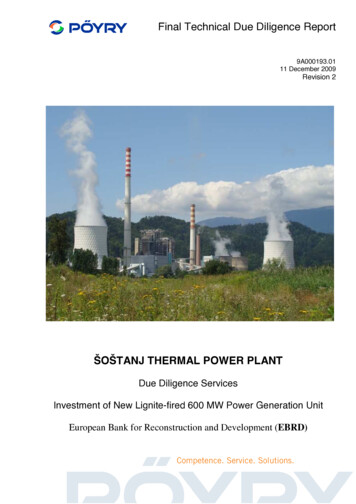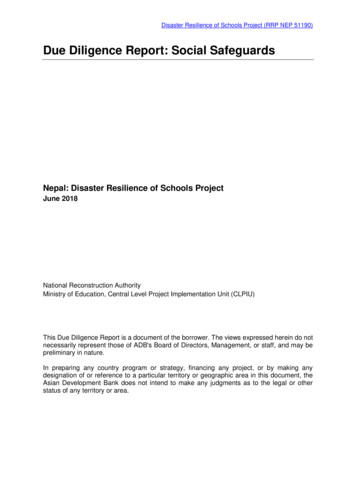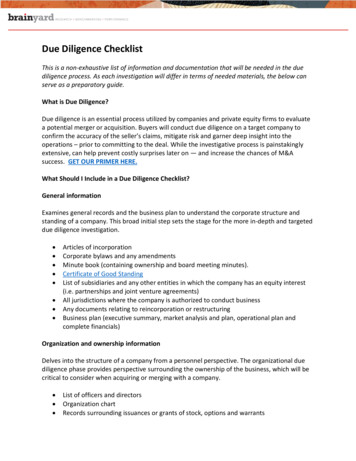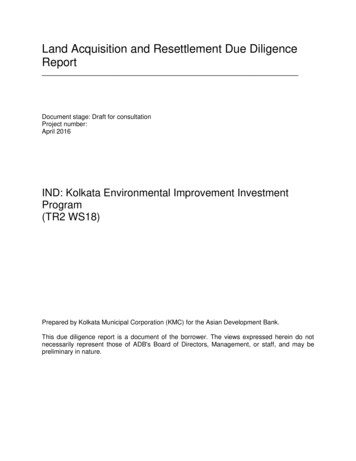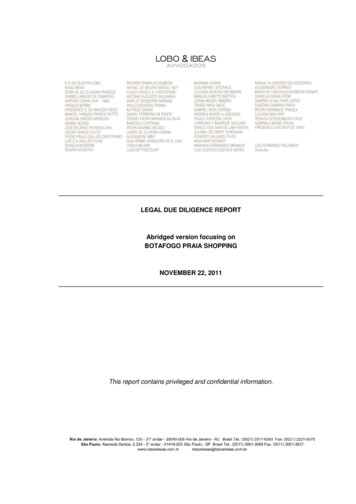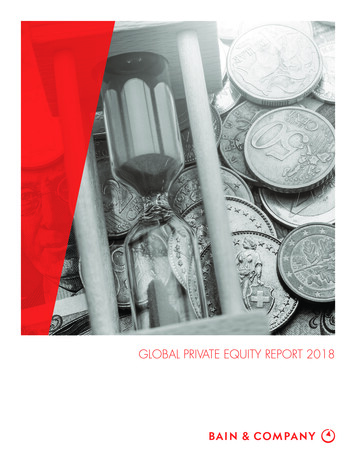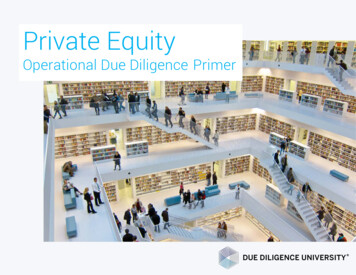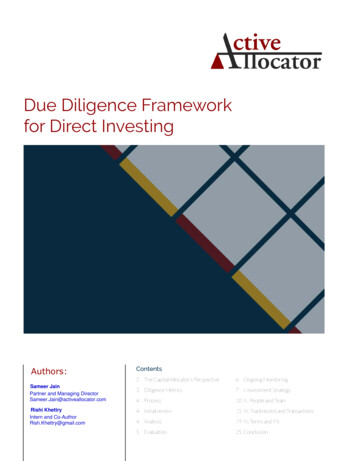
Transcription
Due Diligence Frameworkfor Direct InvestingAuthors:Author:ContentsSameerJainSameer JainPartner,ManagingDirectorPartner andManaging @activeallocator.com2 The Capital Allocator’s Perspective6 Ongoing Monitoring3 Diligence Metrics7 I. Investment Strategy4 Process10 II. People and TeamRishi Khettry4 Initial review15 III. Trackrecord and TransactionsRish.Khettry@gmail.com4 Analysis19 IV. Terms and Fit5 Evaluation25 Conclusionwww.activeallocator.comIntern and Co-Author
www.ActiveAllocator.comThe Capital Allocator’s PerspectiveThe capital allocator is in the business of entering into partnershipswith fund sponsors1 to potentially generate significant returns,mainly through long-term capital appreciation, by making, holdingand disposing of privately negotiated equity and related investments.Such investments are usually made as a passive investor in vehiclesdirected by a third party fund sponsor; as a result, the investor2 hasonly indirect influence over-achieving ultimate investment objectives.We believe that a methodical approach to selecting sponsors—whichcombines scientific rigor with seasoned subjective judgment—may contribute to creating strong results in a variety of economicenvironments. We present here a ‘best practices’ framework forselecting financial sponsors. We draw attention to importantissues, metrics and considerations deemed worthy of exploration.What follows does not represent an exhaustive list, of course. Eachinvestment and operational diligence mission inevitably take onedown paths that are not common to other missions. One must beprepared for this—and even seek it and relish it. For, it is foraysbeyond the common and readily available, that enable real insightinto the people with whom one entrusts with one’s capital.Active Allocator, Inc.//Due Diligence Framework for Direct Investing1 We use the term ‘sponsor’very loosely in this articleto facilitate ease of reading.Investment vehicle structuresvary; for instance, the prevalentlegal structure used by privateequity sponsors is the LimitedPartnership. The Generalpartner is the legal entity withunlimited liability; it servesas the intermediary betweenexternal contributors of capitaland businesses who seek capital.The “Management Company”, alegal entity setup to serve as theinvestment advisor to the fund,is involved with the fund’s dayto-day operations. The sponsortypically designates seniormembers of its organization,usually known as “the principals”,to comprise the General partnerwho actively manage thepartnership, act as agents of thefund and direct its affairs.2 We use the term ‘investor’ veryloosely here to facilitate easeof reading. Investors may beLimited partners, and as the namesuggests, have limited liabilityand are not involved with thefund’s day-to-day operations.They are passive contributors ofcapital and receive income andcapital gains on their investmentin the partnership. Their liabilityis usually limited to their paid andunpaid capital contributions.2 of 25
www.ActiveAllocator.comDiligence MetricsThe due diligence concepts described in this article are applicable to lesser orlarger degrees to most alternative classes including hedge funds, private equity,real estate, commodities, infrastructure, timber as well as oil and gas partnerships.Direct investing in private markets has often been summarized as having threemajor components: finding, grinding and minding. In a narrow sense and for aparticular transaction, that rhythmical summation is right. But these threefactors alone quickly become insufficient when one is making long-term, illiquidblind pool commitments, often commingled with others. The issue gets evenmore complicated when capital is managed by a team that may be changing in itscomposition over time, or one that manages multiple funds in multiple disciplines,or one whose incentives do not map perfectly with the capital allocator’s.We group diligence metrics into four broad areas:I. Investment StrategyII. The People and TeamIII. Track Record and TransactionsIV. Terms and FitIt is important to recognize that these metrics overlap and must be consideredjointly in arriving at a judgment. There is a blend of science and art in thesejudgments. It would be far easier to make capital deployment and sponsor hiringdecisions if all of the data could be quantified, measured and then ranked. Somedata lends itself to this approach—and one must be rigorous in performing thefull menu of quantitative analyses on such data. The most interesting issues inultimately making allocation decisions, however, usually do not lend themselves to adeductively reasoned, scientific analysis alone. Rather they entail making qualitativejudgments. This is part of what makes the job of hiring sponsors interesting andchallenging—and part of why hiring decisions, in general and for direct investingin particular, are anything but a sure shot. Excelling in making critical inductivereasoning judgments, in turn, requires wisdom gained from experience (doing itoneself and studying the successes and failures of one’s own and others).We stress that this article is not intended to be a ‘checklist’ but rather a holisticframework with which to approach investment and operational due diligence indirect investing.Active Allocator, Inc.//Due Diligence Framework for Direct Investing3 of 25
www.ActiveAllocator.comProcessThe sourcing of investment sponsors marks the beginning of the due diligenceprocess. Potential candidates may be drawn from:›› Collective knowledge and experience of team members.›› Referrals from current sponsors.›› Network of financial institutions, including other professional allocators, prime brokersand service providers.›› Research based on subscriptions to periodicals and databases.After sourcing and assembling an initial list of sponsors, an investing team maybegin to narrow down the pool to an actionable list. This is arguably the most timeand resource intensive part of the due diligence process. The objective at this stageis to identify sponsors with a sustainable and repeatable process, which hopefullyleads to a consistent returns stream in the future.Initial reviewThis generally involves gathering preliminary information from initial calls and/ormeetings. This provides a high-level overview of key investment and operationalaspects of the fund, including:›› Investment philosophy and strategy.›› Investment process.›› Quality and depth of research.›› Portfolio construction.›› Risk management.›› Corporate structure.AnalysisAfter an initial review, an investing team usually performs a more in-depth analysisto gain a complete understanding of investing process. Information is reviewedand analyzed to understand the process of returns generation as well as anunderstanding of risks being assumed to generate those returns. The endeavorusually is to learn more and build internal conviction.The analysis process involves:›› Multiple meetings and interviews.›› Documentation requests and a review of marketing materials.›› Provided references which may be both personal and professional.›› Completion of a due diligence questionnaire.Active Allocator, Inc.//Due Diligence Framework for Direct Investing4 of 25
www.ActiveAllocator.comAfter collecting and analyzing information, an investing team usually crossreferences collected facts with unaffiliated sources. An independent affirmationof facts verifies sponsor assertions and further helps to build conviction. Here, theinvesting due diligence team may look at:›› Background checks.›› Civil and criminal court checks.›› Industry checks, including with SEC, FINRA.›› Credit checks.›› Education verification.›› Review of government filings and forms—e.g., 13G/Ds, 13Fs, Form ADVs.›› Audited financial statements.›› Public information searches.›› Reference calls including calls made to former employees or former investors.EvaluationA number of criteria are taken into consideration and will vary depending on thesponsor, the strategy being deployed or how the fund is expected to be offered toclients. Here, qualitative and quantitative considerations include:Qualitative›› The degree of conviction with the team and the investment strategy.›› Background and experience.›› Portfolio construction and risk management discipline.›› Strategy viability through a complete economic cycle, including a historical and expected futurerisk/return profile.›› Ability to generate consistent performance over time, on an absolute basis, and/or versus anappropriate peer universe if relevant.QuantitativeRelevant metrics include:›› Absolute historical level of returns.›› Volatility which measures the dispersion of changes in price.›› Correlation which measures the degree to which the movements of two financial instruments arerelated.›› Drawdowns, which is another measure of risk.Performance comparison of the sponsor’s performance to:›› Other similar funds.›› Peer universe as applicable.›› Relevant indices.Active Allocator, Inc.//Due Diligence Framework for Direct Investing5 of 25
www.ActiveAllocator.comOperational EvaluationOperational risk analysis is a key factor in avoiding fund failure and managerfraud. It is important to build review procedures to enhance the ability to protectfrom such risks. Operational due diligence typically includes an analysis of funddocumentation, contractual arrangements, valuation methodology and pricingbasis (including analysis of mark-to-market versus mark-to-model practices) andthe strength of key service providers and administrators. It inevitably reviewsoperations infrastructure, systems, processes and controls including middle- andback-office staff qualifications and capabilities. It also includes ongoing mediaand background check monitoring and considers the independence and qualityof service providers. Lastly, it involves understanding the firm’s approach toinfrastructure issues including ways in which the firm is positioned to handlegrowth in assets/or clients, personnel needs, client service functions and disasterrecovery backup arrangements.Ongoing MonitoringAfter an investment decision is made it is important to conduct ongoing diligenceand monitoring. As with any active management strategy, the goal is to arrive at anearly identification of factors that could cause future under-performance. This isan ongoing check to ensure that the agreed upon investment strategy is deployedin a manner that is consistent with the expectations established during the duediligence process.The investing due diligence team, may in instances, review and evaluate changesto the investment and/or operational framework and regularly reaffirm itscommitment to a sponsor. Ongoing monitoring activities may occur on a bi-monthly,monthly, quarterly or annual basis, depending upon the task at hand. Of course,the unexpected may occur, which can lead to impromptu visits or discussions witha sponsor as well. It is important to develop a regimented process that consists of anumber of activities, some of which include:›› Conduct regular on-site visits and calls.›› Review performance.›› Understand the profit/loss attribution.›› Evaluate risk exposures.›› Review outlook.›› Explore any material changes to the organization.›› Ensure that there is no style drift.We now turn to examining in greater detail the four pillars of the duediligence process; the investment strategy, the team, track recordand transactions, as well as commercial terms and fit.Active Allocator, Inc.//Due Diligence Framework for Direct Investing6 of 25
www.ActiveAllocator.comI. Investment StrategyThe risk and return attributes of direct investments are determined by theirinvestment strategy. The common element amongst strategies is the use ofinvestment and risk management skills to seek positive returns; it is for this reasonthat good sponsors place particularly strong emphasis on the disciplined use ofinvestment and risk control processes. Often direct investment sponsors havereasonably flexible mandates which allow for manager strategy to evolve as marketconditions change.The investment due diligence process involves reviewing the sponsor/key risktakers’ professional pedigree, including their credentials, reputation, performanceevaluation versus peers and benchmarks, as well as the duration of such trackrecords.Attributes of the good sponsors include:›› Excelling in systematically and dynamically analyzing the underlying markets and identifyingconditions that might provide absolute return opportunities.›› Having superior security selection skills and trade expression capabilities.›› Deploying a disciplined risk management approach.›› Being nimble in allocating capital across opportunities.Therefore, getting access to sponsors who have market knowledge and experienceacross varying markets and cycles, or who use advanced analytical tools, havedeveloped risk management processes, provide expression in flexible investmentvehicles, and have an edge in exploiting fleeting opportunities is important. The duediligence function involves assessing these attributes and several other aspectsincluding:›› Investment theses and the process of arriving at them.›› Investment philosophy.›› Complexity of the investment strategy.›› Sizing the trade and portfolio construction.›› Organizational stability.›› Employee turnover and compensation schemes.›› Assets under management.›› Costs, fees and pricing structure.›› Liquidity conditions.›› Operational and control checks.Active Allocator, Inc.//Due Diligence Framework for Direct Investing7 of 25
www.ActiveAllocator.comNext, we highlight questions that might help investors evaluateinvestment strategy:What is the fund’s investment strategy?›› Categorize:By geographyBy industryBy stage of developmentBy fund sizeBy size of a typical transaction›› Why has this strategy been selected?›› How attractive is this strategy now?›› For how long will this strategy be effective?What are sources of likely returns?›› These might include:Growth in cash flow (organic and acquisitions related)Financial leverageMultiple expansionCustomer tractionRevenue growthGrowth in the size of addressable marketPath to profitabilityIn executing this strategy, identify “edges”/sources of value creation?For example:›› Strategic relationships›› Leveraging the network and skills of operating partners/industrial partners›› Leveraging relationships and know-how of Board of Directors/Board of Advisers›› Effectiveness in corporate partneringActive Allocator, Inc.//Due Diligence Framework for Direct Investing8 of 25
www.ActiveAllocator.comBenchmarks: An acceptable industry-wide standard for comparing direct investingperformance does not presently exist. The illiquid nature of such investments doesnot lend itself readily to comparisons with a single benchmark measure. Also, manyfunds do not usually publish their returns data, though a few fund of funds andconsultants maintain their own proprietary databases.What are the proper benchmarks for the strategy? How appropriate are they?›› What magnitude of returns ought this team generate in executing the strategy? How would returnscompare with others executing the strategy at this time on a risk-adjusted basis?›› Factors affecting the ability of the fund to execute its investment strategy:In order to ensure that the sponsor does not raise more capital than it caneffectively deploy without compromising the fund’s investment thesis, upperbounds on fund size are quite frequent. Conversely, the fund memorandum mayspecify the minimum size at which the fund may close. Questions may be directedto ascertain:›› The fund size.›› Number of transactions to be done.›› The intended investment bite sizes.›› The need for follow-on investment.The availability of leverageThe need for co-investorsActive Allocator, Inc.//Due Diligence Framework for Direct Investing9 of 25
www.ActiveAllocator.comII. People and TeamInvestors in direct investment funds tend to emphasize an evaluation of teamcomposition, individual and collective track record, team synergy, team resilienceand team economics before they decide to invest. Inquiries may be made toestablish:›› What about the principals make them well-suited to execute their strategy?›› Have they ever executed this strategy previously? For how long?›› How well do the principals understand their sector and the factors that are likely to influencesuccess or failure?›› How adaptable will the principals be if the environment changes so as to inhibit the effectiveness ofthis strategy?There are two major components to addressing the team’s likelihood of success:›› Partner/Team Analysis: appreciating the people.›› Skills Analysis: assessing to what degree the team possesses relevant skills.Partner/Team AnalysisWho are the partners of the fund? Who are the key contributors executing thestrategy?›› What are their backgrounds and accomplishments?›› What are their strengths and weaknesses?›› What makes each one “tick”? What has made them successful in their prior endeavors? Are theysufficiently motivated to succeed going forward? What might be influencing their motivation?›› When have they failed? Why?›› What, if anything, truly distinguishes each principal or the team as a whole? Have they developed a“franchise” with enduring value?›› For what are they known, if anything? Who respects them? Who doesn’t? Why?What diligence and background checks have been done on the key people?›› What can be learnt? In particular, what was said about the principals by:Portfolio company sponsors.Limited partners.Those who have previously invested with them.Capital sources.Deal intermediaries.Former partners and employees.›› Were there areas about their backgrounds about which the principals were not forthcoming?›› What inferences can one draw about the principals from meetings and the checks performed?Active Allocator, Inc.//Due Diligence Framework for Direct Investing10 of 25
www.ActiveAllocator.com›› Any existing or historical personal/professional interactions with the principals? How revealing werethese? How exceptional were they?›› What has one learned from checkings beyond a provided reference list?What has been the experience of the principals working together in the past?›› Have they invested together in the past? For how long? How successfully?›› For how long and in what way/capacity do the principals know each other?›› How did the principals come together to form their firm? When?›› Do the people comprise a good team? Are their skills and personalities complementary?What has been the change in the team’s composition over time?›› Who joined when? Why? Who has joined recently?›› Who has left the firm? When? Why, according to the principals? Why, according to the departed?›› Are the principals responsible for creating previous performance still as actively engaged?Is material change expected in this regard going forward? Are the newer partners doing adisproportionate amount of the work? What might this suggest about future performance?How many people comprise the sponsor?›› Number of employees?›› Number and quality of partners? Senior partners? Junior partners?›› Number and quality of principals (those sharing in the profits)›› Number and quality of non-principals?›› Number and quality of “Operating partners”?›› Number and quality of “Entrepreneurs-In-Residence”?›› Number and quality of Advisory Board Members?Is the fund sized right? Do the team’s track record and ability to source deals relatefavorably to the size of the fund? How much capital will the team be managing?›› Total in all vehicles›› Per professional›› Per partnerWhere are the team members located? How effectively do they communicate witheach other? Do their locations and pattern of communications help or hinder theexecution of their strategy?How does the sponsor’s investment decision process work? Does it really functionas described? Do one or two people dominate the decision? Must all partnersagree? Super-majority? Consensus? How often is there disagreement? Is thedecision process consistent? Sensible? Adaptable?Active Allocator, Inc.//Due Diligence Framework for Direct Investing11 of 25
www.ActiveAllocator.comHow have the principals dealt with conflict situations with sellers, companysponsors, limited partners, partners of their firm, non-partners of their firm, otherinvestors, lenders and other capital providers, deal intermediaries, and others?Sponsor Investment. How much is each member of the Sponsor contributing asinvested capital?›› How does this compare with each person’s net worth/liquid net worth?›› How much of his/her capital is in other funds managed by this sponsor?›› What percent of the fund do the General Partners represent in the aggregate?›› Are there other affiliated entities investing substantial capital? Are they receiving different forms oramounts of economic value for such investments?How are the economics shared among the members of the General Partner?›› How are the allocation economics decided? Is the process fair and understandable?›› How frequently is the economic split re-evaluated? Has it been done recently?›› Is the sharing equitable? How does the team feel about the economic split? Are any of the keyprincipals likely to leave over the course of the partnership?›› How many individuals have a share of the carried interest? How much is held by:Founding partners?Senior partners?Junior partners?Non-partner employees?Affiliates and former affiliates?Is there a succession plan? How believable? Will investor’s capital be well cared for?Skills Analysis:Do the individuals and the team have the requisite skills to execute the strategywell? Distinguish between a record of achievement in each of these skills versus afamiliarity with the task.›› SourcingQuality? Quantity? How “proprietary”? How “exclusive”?›› Analyzing/SelectingHow systematized is the analytical process?How truly thorough is diligence?How well does the team evaluate risks and rewards?What has been the quality of thought about deals previously selected and those passed over?Are the principals “good buyers” of businesses?What is the quality of investment write-ups?Active Allocator, Inc.//Due Diligence Framework for Direct Investing12 of 25
www.ActiveAllocator.com›› Structuring/Negotiating TransactionsWith owner/seller.With company sponsors.With capital sources.Has the investment team demonstrated creativity in approaching the structuring and financingof transactions?›› Sizing InvestmentsRelative to the risk of capital loss.Relative to fund/vehicle size.›› Adding Value to Portfolio (if relevant)Strategy.Acquisitions.Hiring sponsors.Operational issues.Fixing problems.Serving as “Interim-CxO” if situation warrants.›› Realizing ValueHow well has the investment team assessed exit opportunities at the time of the investment?How does the investment team make judgments about exiting after the investment is made?How effectively has the investment team exited investments?Does the team believe that they are “good sellers”?›› Communication and ValuationHow well does the fund communicate with its investors?How efficient is the back-office?How timely are quarterly/annual reports?How well can one understand the performance of the fund and the underlying portfoliocompanies/ properties from distributed material?When investors have questions, how helpful is the sponsor? Response time?Does the investment team understand how to mark the portfolio properly?Does the investment team understand how to value investments for accounting purposes?How realistic and appropriate are portfolio valuations/marks?Active Allocator, Inc.//Due Diligence Framework for Direct Investing13 of 25
www.ActiveAllocator.com›› How good are their skills? In particular, how good are the principals in:Assessing company sponsors?Working with company management?Monitoring portfolio companies or properties or underlying investments?Adding value to portfolio companies?›› How does one assess the people and the team from the perspectives of:Competence?Trust and integrity?Serving as a fiduciary?›› Are there meaningful differences between how one independently assesses the investing team’sskills (versus how the principals describe themselves and versus how others assess them)? What dosuch differences suggest?Active Allocator, Inc.//Due Diligence Framework for Direct Investing14 of 25
www.ActiveAllocator.comIII. Track Record and TransactionsMany direct investing firms start off small, often with in-house or proprietarycapital, and build a track record of success. Those that succeed in creating goodperformance go on to market themselves to outside investors. As an indicator ofhaving the requisite skills, it may be important to evaluate the track record andtransaction history of the principals—remaining mindful that past performance isnot necessarily an accurate predictor of future performance.Fund management experience and ability.›› As a group, have the principals managed one or more similar vehicles or funds previously?How many? How much capital has been invested?How many vehicles and how much capital is being currently managed?›› Have the individual partners managed one or more similar vehicles previously, but not as a team?How many funds have they managed and with how much capital?Are there sufficient grounds to assume that the investment vehicle in consideration is a quasifirst-time fund?It often helps to understand returns by getting information on a cumulative basis, a fundby-fund basis and a deal-by-deal basis for all deals completed by all partners of this sponsor(including, separately, any prior investments for which each person was meaningfullyresponsible).On a fund-level basis, performance evaluation may include:›› Vintage year.›› Fund size.›› Management fee.›› Carried Interest (and Preferred Return, if any).›› Number of transactions completed.›› On a “net-of-all-fees, expenses and carried interest” basis:Capital invested and capital committed.Capital returned on both a “cash returned” and a “cash returned to investors value ofholdings” (valuation) basis.Multiple of Capital Returned (on a “cash only” basis and on a “valuation” basis).Internal Rate of Return (IRR%).Average holding period.›› On a Gross Portfolio basis, on a Realized Transactions-only basis and on an UnrealizedTransactions-only basis:Capital invested.Capital returned/valued.Multiple of Capital.IRR.Number of Winners/Number of Losers.Active Allocator, Inc.//Due Diligence Framework for Direct Investing15 of 25
www.ActiveAllocator.comAnalyze returns and their distributions (both IRRs and Multiples of Capital).›› Understand dispersions of returns versus each of:Amount of invested capital.Time.›› What has been typical? Understand (and distinguish by type of deal if the sponsor invests inmultiple types of strategies) the typical return profile of this sponsor’s investments. What hasbeen the:Mean return? Median return ? Typical range of returns?›› Concentration. How concentrated are returns to one or two large successes? Was this part of thestrategy? How would the investment vehicle perform absent such major successes (and perhaps anequivalent number of failures)?›› Comparative results. How does each vintage year fund compare with an appropriate universe ofsimilar funds/ investments?›› Create a composite performance picture for all funds/investments managed by the principals.On a deal-by-deal basis, for each major transaction, focus on:›› How was the transaction sourced, and by whom?›› What was the investment thesis? Was it sound? Was it executed well?›› How did the sponsor appraise the risks and rewards at the time of decision? In light of thetransaction’s potential payoff and the likelihood of the risks occurring, was it reasonable/prudent toassume those risks?›› How did the sponsor approach the valuation? Why was the price paid appropriate/attractive in theeyes of the sponsor? In particular, at the time of investment (and where relevant, at time of exit),what was the:Date of first and subsequent investment(s).Amount of capital invested for each investmentPurchase price (or valuation) for entire Enterprise or Pre-and Post-Money ValuationLevel of Cash flow or other metric (e.g., Run-Rate EBITDA, Trailing EBITDA-CapEx, ProjectedRevenues)Relevant Multiple on a Total Enterprise Value basis relative to “cash flow” or other metricCapital structureDebt multipleHow fast was company growing/expected to grow?How quickly did sponsor expect debt to be paid down?›› How thorough was the sponsor’s diligence?›› How skillful was the investment team in structuring their investments and sizing themappropriately?›› Who was involved with the company post-closing?Were one or more board seats held and if so, by whom?In what other capacity was the fund sponsor involved?How effective was the value-add?Active Allocator, Inc.//Due Diligence Framework for Direct Investing16 of 25
www.ActiveAllocator.com›› What were the sources of value-add?SourcingIndustry expertise/ContactsOperational expertiseRecruitingFinancial engineeringRestructuringAbility to work effectively with management›› Were any management changes required?How well-anticipated were those changes?How effective has the new sponsor(s) been?How timely and effective was any remedial action taken?›› What were the investment results?What was/has been the multiple of capital achieved (realized and total) and the IRR%?How did the investment team exit/realize their investment?What went according to expectations? What did not?Could/should the situation(s) that arose have been anticipated?On an overall basis for all deals reviewed:›› “Our kind of deals”. Were these the kinds of transactions in which one would have liked to haveone’s capital exposed (both with and without the benefit of hindsight)?›› Will the future be like the past? Is there any reason to believe that past success will not be indicativeof future success?›› Older, but wiser? Does it see
Apr 14, 2016 · Diligence Metrics The due diligence concepts described in this article are applicable to lesser or larger degrees to most alternative classes including hedge funds, private equity, real estate, commodities, infrastructure, timber as well as oil and gas partnerships. Direct investing in private
